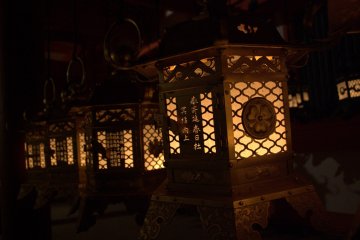
Setsubun Mantoro 2026
Jessica LinAt the Kasuga Taisha Shrine in Nara, more than 3,000 lanterns in the precincts are lit up.

The great Kasuga Shrine (Kasuga Taisha) is located in Nara Park. It was built at the same time as the capital and is dedicated to the deity responsible for protecting the city. The shrine was recognized as a UNESCO World Heritage Site in 1998.
The most distinctive feature of the shrine is its 3,000 lanterns. Both stone lanterns and bronze lanterns were donated by believers and decorate the interior of the shrine. All 3,000 lanterns are lit twice a year. The first celebration in February (Setsubun Mantoro) represents the beginning of spring. The second celebration in August (Chugen Mantoro) honors the gentle transition into autumn.
The shrine is also home to the Kasuga Taisha Museum, which houses some of the relics. This includes two sets of large, ornate drums.

At the Kasuga Taisha Shrine in Nara, more than 3,000 lanterns in the precincts are lit up.

Kasuga Taisha Shrine is one of the ancient symbols of Nara. Some of shrine's highlights include deer, wisteria and 3,000 lanterns.

Kasuga Taisha (Kasuga Grand Shrine) is one of the oldest and most famous Japanese shrines in the central Nara area

Discover the wonders of Nara's Kasuga Taisha Shrine.

Visit Kasuga Taisha Shrine in Spring and enjoy the unique ambience of weeping cherry blossoms against a striking background of red pillars and tawny Hinoki cypress.

The Kasuga Shrine has its own place in Japanese history, but to the average traveler is it hard to ignore the 3000 plus lanterns that litter the entrance path.
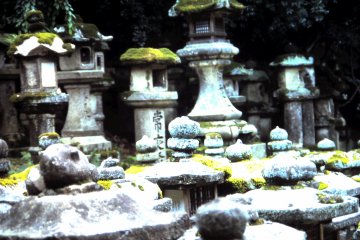
Walking along the path that leads to Kasuga Taisha shrine is like walking back in time, to a place where time stood still, where nature and human arts combine beautifully.

Traditional performing arts can be enjoyed at this annual festival held since the 12th century.

At the Kasuga Taisha Shrine in Nara, more than 3,000 lanterns in the precincts are lit up.

Nara is a relatively small city that has several options when it comes to deciding on a place to stay. One of these places is Hotel Sunroute and somewhere that is definitely
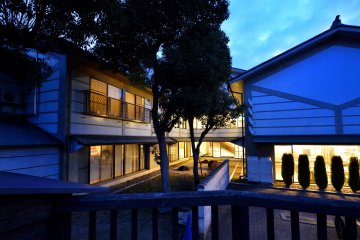
Hotel Wellness Asukaji is a typical Japanese BBB (Bed, Bath and Breakfast). This conveniently located hotel just off of Nara Park offers a tranquil, relaxing low key option for those headed to Nara for a weekend getaway.

Luxury hotel in the heart of Nara Park, located near Kofukiji and close to Araike lake.

During the summer season, at Kurokawa Honke (黒川本家), located in Nara city, many dishes with arrowroot incorporated, like the cold pasta made with arrowroot starch, are served. The restaurant is a mid-range, stylish, and chic location that offers a peaceful and welcoming dining atmosphere and experience.
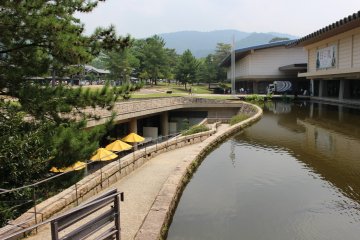

Nara has a long and rich history, and it shows in the amazing variety of food unique to the area.
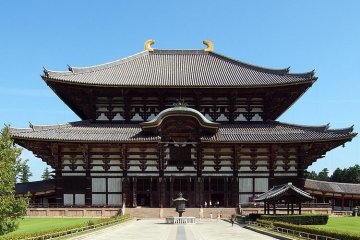
Todai-ji Temple, also known as the Great Eastern Temple, was originally built in 752 at the behest of Emperor Shomu. It is one of the most famous and historically significant temples in all of Japan and one of the landmarks of Nara. The Todai-ji Temple is a UNESCO World Heritage Site. Until recently, the main hall of Todai-ji, Daibutsuden, was the largest wooden building in the world. The massive structure houses one of the largest cast bronze Buddha statues (Daibutsu) in Japan, which is 15 meters tall. Another popular attraction is a pillar with a floor-level hole that is exactly the size of the Buddha's nostril. Whoever manages to squeeze through this opening will supposedly reach enlightenment in the next life.

NARA Visitor Center & Inn is located by the Sarusawa Pond in Nara City, a short walking distance from Kintetsu Nara station and Nara station. It is the hub for all travel resources when visiting Nara. If you have any questions, need travel recommendations, or are looking for transportation guidance this is the stop to make. The visitor center offers services that will ease your travels in Nara. Find an ATM serving overseas cards and foreign currency exchange at the service counter. Drop your bags off at the baggage storage to rid the excessive weight off your shoulders as you explore the nearby areas. The travelers lounge is equipped with computers and i-pads available for use free of charge. If they are taken, use the free Wi-Fi, to start planning your adventure on your own devices. Find pamphlets and maps for basic information and tips on where to go. The multilingual staff are also extremely helpful and are happy to share the must-see sights and eats that you will not find in travel pamphlets. In addition to the many services offered here, you will find daily walking tours and free cultural activities to participate in. This is a great chance to learn and experience the art of Ikebana (flower arranging), dress in a Tempyo gown, or challenge yourself with Japanese calligraphy. Take the free excursion buses available every Tuesday, Thursday, Saturday and Sunday until October 31st, for a ride to either Asuka Village or Mount Yoshino. The famous sights and activities are not limited to Nara City so don't miss out on this opportunity to explore all the beauty Nara Prefecture has to offer!

Toshodaiji Temple, located just north of Yakushiji Temple in Nara, is a significant site related to the development of Buddhism in Japan and signifies a connection between Japanese and Chinese cultures. The prestigious temple was founded in 759 by the Chinese monk Ganjin, who traveled to Japan in 754 after being asked by the emperor to help train monks and improve Japanese Buddhism. After retiring, Ganjin was granted land and consequently, established Toshodaiji to continue teaching Chinese Buddhist principles. Today, the temple is recognized as a UNESCO World Heritage Site. Without a doubt, Toshodaiji’s most impressive structure is its Kondo, or Main Hall, which was reopened to visitors in 2009 after nearly ten years of reconstruction work. The one-story Kondo, situated directly behind the Nandai-mon (Southern Great Gate), is the epitome of early Japanese-Buddhist architecture with a tiled sloping roof, seven bays, columns, and dark wood tones. Due to the building’s columned facade, it is often compared to the Parthenon. Inside, the hall houses principal Buddhist statues, which are designated as National Treasures. Standing before the hall, you cannot help but be swept away by its commanding presence. Near the Kondo is the Kodo Lecture Hall. This structure was originally built as an administrative building for the Nara Imperial Palace, but later relocated to Toshodaiji after it was gifted to Ganjin. Today, the hall is the only surviving building of the palace, and thus, a historically significant and rare part of the temple. Another prominent temple building is the Miei-do, which enshrines a famous wooden sculpture of Ganjin that his disciples created using hollow-core, dry-lacquer techniques. The exclusive building is only open to the public for a few days a year around June 6th. For all other days, visitors can view a replica of the statue, which was made on the 1,250th anniversary of Ganjin’s death, on display at the nearby Kaizando. In the eastern woods of the precinct lies Ganjin’s grave, one of the most tranquil areas of the temple. Follow a nature-laden path through thick foliage and then cross over a small bridge into the peaceful haven. Toshodaiji is also home to monk sleeping quarters, storehouses for sutras and treasures, and the Koro (Shariden), which is the site of the Uchiwamaki Ceremony, or Fan Scattering Festival, on May 19. Be sure to visit this remarkable temple and walk the footsteps of one of the most influential Chinese monks of Japanese Buddhism.